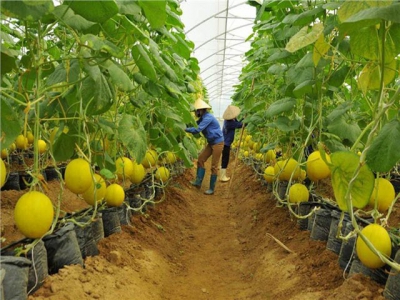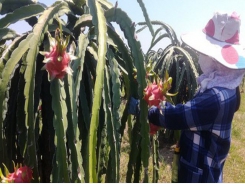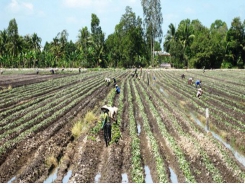Hi-tech agriculture in HCMC enjoys promising results

Thanks to the national targeted program ‘New Rural Development’, in the last 5 years, the living standards of residents in suburban areas of Ho Chi Minh City (HCMC) have witnessed great improvement. In such a mega city where agriculture only accounts for a small proportion in the city's economic structure, the continuous rise in performance and gross output over one hectare of agricultural land is truly impressive.
Lately in HCMC, there have been various novel models of urban agriculture and hi-tech agriculture, significantly increasing people’s income. These models are able to attract both experienced farmers and well-educated agriculture lovers.
Take the case of Ms. Nguyen Thi Thanh Dung as an example. Giving up the job of a white-collar officer, she came back to her home in the suburban district of Cu Chi and started up a hi-tech orchid farm of her own. She spent months after months visiting successful orchid farms in the nation to gain more expertise and tips. Then she boldly applied for a preferential loan from her district to buy seeds as well as proper equipment. Thanks to implementing advanced technologies, she is able to save much overhead cost on her 15,000-square-meter farm while earning around VND200-300 million (approx. US$8,618 – 12,920) per month now. Presently, she is researching new automatic systems to spray pesticide for her trees.
A similar story happens with a 24-year-old girl living in Tan An Hoi Ward of Cu Chi District. The girl, Nguyen Ngoc Huong, has decided to start up with a 10,000-square-meter Asiatic pennywort farm, which is commonly regarded as wild low-profit vegetable in Vietnam. Encountering several obstacles from changing plant, fighting pests and weeds, to persuading customers to change their use habits, the girl was so depressed that she wanted to give up. Yet when realizing that smart applications of technologies and obtained knowledge can help farmers improve their life and develop to the fullest, Huong gave one last try, with the financial aid from the local authorities. From time to time, she did research on the ideal end-product to meet the market’s demands.
At present, her farm has 6 different types of output from fresh vegetable to dried powder with the brand name Quang Thanh. One of them even won the award ‘Vietnamese High-quality Goods 2020’, and received orders from Holland in 2019. Now her farm has a revenue of more than VND4 billion ($172,368) per year, offering a full-time job for nearly 20 people and part-time job for another 15-18 people. Huong is collaborating with other local farmers to transfer her technologies in hope of helping them have a more stable income.
One more noticeable instance is Mr. Tran Van Tan, owner of Nghia Nhan abalone mushroom farm in Nha Be District. Refusing the online rumor that this kind of vegetable can easily earn a large amount of money, he commented that it takes much care and investment to maintain and develop a mushroom farm.
After years of self-studying suitable mushroom growing methods, Mr. Tan now operates a successful farm with beautiful earnings each year. He never stops supporting other local poor farmers who are determined to work hard to improve their life. Mr. Tan enthusiastically shared that he had a plan to multiply his farm model to other farmers since the market’s demands are still positively high. He also wants to pilot new mushroom kinds and better control the seed source.
Working in the field of agricultural science, Anh Dao Science Technology Agriculture J.S.C., located in Nha Be District, has an ideal research and development team of 1 associate professor, 2 doctorates, many masters and bachelors of science among its 120 employees, along with a professional consultation team. Each year, the company is able to produce millions of seedlings and culturing tissues. Notably, this company was successful in developing a new high-performance macapuno type using high technologies. It has transferred various plant growing technologies to local farmers, and is going to cooperate with foreign partners such as Thailand, Japan, Taiwan to learn more useful technologies regarding organic vegetable farming and poly house farming.
After 10 years running the national targeted program ‘New Rural Development’, the average income of HCMC farmers has increased by 2.72 times, from VND23.17 million ($1,000) per person per year in 2010 to VND63 million ($2,716) in 2019.
Obviously, investments in traffic infrastructure, irrigation, high technologies for effective farming have reaped success and become an encouragement for companies as well as individuals to confidently focus more on high-income high-yield plants.
Traditional working models of Vietnam like agricultural cooperatives also receive much promotion for development. Take, for example, Huyen Thoai Cooperative in Cu Chi District, which does business on orchids. In 2015, it has 8 members with a cultivation land of 18ha. Presently, the number of members doubles, with a cultivation land of 25ha to provide 8 billion sprigs of orchid and 100,000 seedlings per year.
Participating in a cooperative helps to reduce overhead cost while boosting competitiveness a great deal.
Many traditional handicraft villages in HCMC such as Phu Hoa Dong girdle-cake village or Thai My weaving village in Cu Chi District are now paid more attention and gradually back to their heyday. Thanks to proper encouragement policies of the local authorities, they are able to export their products to other countries like the US, Japan, Taiwan.
Có thể bạn quan tâm
Phần mềm

Phối trộn thức ăn chăn nuôi

Pha dung dịch thủy canh

Định mức cho tôm ăn

Phối trộn phân bón NPK

Xác định tỷ lệ tôm sống

Chuyển đổi đơn vị phân bón

Xác định công suất sục khí

Chuyển đổi đơn vị tôm

Tính diện tích nhà kính

Tính thể tích ao hồ



 US enterprises green-lighted to export meat, seafood, fruits…
US enterprises green-lighted to export meat, seafood, fruits…  Farmers in sugar cane islet switch to grow…
Farmers in sugar cane islet switch to grow…